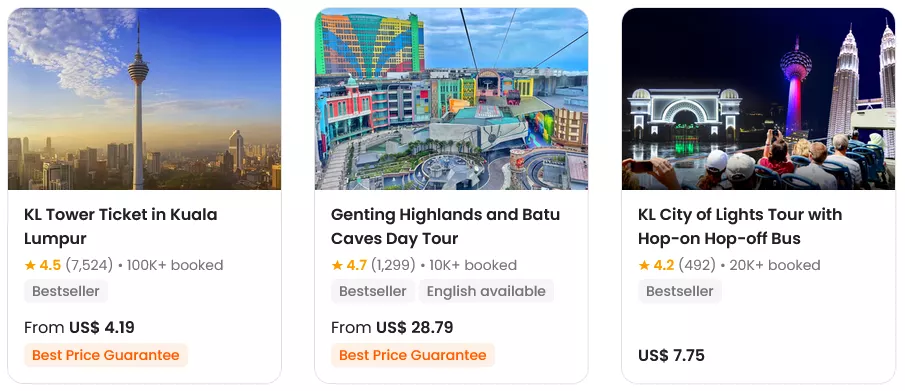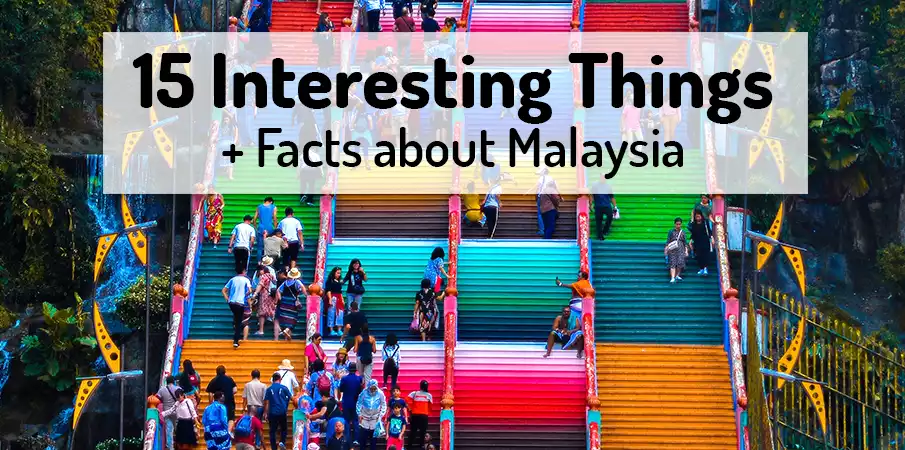
Quick answer: Malaysia is a vibrant and diverse country offering a mix of ancient natural wonders and modern urban life. From the world’s oldest rainforests and massive cave systems to iconic skyscrapers and lively cultural festivals, Malaysia has something for every traveler. Its rich history, unique traditions, and stunning landscapes make it a fascinating destination to explore. Whether you’re into nature, culture, or city life, Malaysia’s blend of old and new is sure to impress.
At a glance:
- 🌿 Home to one of the world’s oldest rainforests, Taman Negara.
- 🏙️ Petronas Twin Towers were the tallest twin buildings worldwide.
- ⛪ Batu Caves, a major Hindu pilgrimage site with limestone caves.
- 🎵 Rainforest World Music Festival blends traditional and modern music.
- 🏞️ Gunung Mulu Park has huge cave systems like Sarawak Chamber.
- 🌸 Rafflesia flower, one of the largest and smelliest flowers.
- 🏰 Bujang Valley holds ancient Malay ruins over 1,500 years old.
- 🎭 Unique monarchy with king elected from state sultans every five years.
Last updated in November 2025.
A Journey through Culture, Nature, and Heritage of Malaysia.
-
- Nestled within the heart of Southeast Asia, Malaysia beckons with a symphony of cultural hues, natural wonders, and a rich historical narrative that echoes through its landscapes. As we extend our heartfelt wishes to Malaysia on its 1-year birthday celebration, it’s an opportune moment to delve into the kaleidoscope of experiences that defines this enchanting nation. From the bustling metropolis of Kuala Lumpur to the serene shores of Langkawi, Malaysia is a fascinating amalgamation of tradition and modernity, seamlessly weaving together a narrative that reflects the spirit of unity in diversity.
- Spanning the Malay Peninsula and the island of Borneo, Malaysia is a testament to the harmonious coexistence of various ethnicities, religions, and traditions. Each facet of the country tells a story—be it the vibrant street markets echoing with the sizzle of satay, the towering Petronas Towers standing as sentinels of progress, or the ancient rainforests whispering tales of biodiversity. As we embark on this journey to uncover the captivating facets of Malaysia, let’s celebrate the nation’s vibrant culture, its architectural marvels, and the natural wonders that have charmed travelers for centuries.
Discovering Malaysia: 15 Fascinating Facts about the Land of Diversity.
-
- In a world where diversity is often a source of strength, Malaysia stands as a shining example of how myriad cultures can coalesce into a harmonious whole. The echoes of call to prayer from mosques, the vibrant celebrations during festivals, and the daily rituals of various communities create a cultural symphony that is uniquely Malaysian. It’s a land where the past and present dance in harmony, where tradition and innovation walk hand in hand, and where the warmth of hospitality extends a hearty welcome to all who venture onto its shores.
- As we embark on this odyssey through Malaysia’s enchanting tapestry, we invite you to immerse yourself in the vibrant markets, traverse through the ancient rainforests, and stand in awe beneath the towering architectural marvels. Each experience is a thread in the intricate fabric of Malaysia, and together they form a narrative that beckons exploration and celebration. Happy 1-year birthday, Malaysia—may your diversity continue to be a source of inspiration for generations to come.
- These 15 fascinating facts below provide a glimpse into the nation’s vibrant tapestry. From culinary delights to natural wonders, Malaysia’s diversity is its strength, creating a harmonious blend of tradition and modernity. As we continue to explore and appreciate the unique facets of Malaysia, we celebrate a nation that truly stands out in the heart of Southeast Asia. Before you arrive to Malaysia, read this article about the most interesting things.
BOOK a TOUR / ACTIVITY in Malaysia ➜
15 Interesting Things + Facts of Malaysia:
1. Culinary Extravaganza: Nasi Lemak and Beyond
Embarking on a culinary adventure in Malaysia is like stepping into a world where flavors dance on your palate. At the heart of this gastronomic extravaganza is the iconic dish—Nasi Lemak. In Malaysia, every meal is a celebration, and every dish is a chapter in the nation’s culinary story. Whether savoring the simplicity of Nasi Lemak or exploring the myriad flavors beyond, the culinary extravaganza in Malaysia is a feast for the senses that leaves an indelible mark on the taste buds and the heart.
Nasi Lemak: Malaysia’s Culinary Crown Jewel
-
- Nasi Lemak, a dish synonymous with Malaysian cuisine, is a fragrant symphony of coconut-infused rice, anchovies, peanuts, boiled eggs, and the fiery kick of sambal. This breakfast staple transcends its humble origins, standing as a culinary ambassador that introduces the world to Malaysia’s diverse flavor palette.
Beyond Nasi Lemak: Diverse Delights Await
-
- While Nasi Lemak reigns supreme, Malaysia’s culinary landscape is a treasure trove of diverse dishes influenced by Malay, Chinese, Indian, and indigenous traditions. From the savory delights of Char Kway Teow to the aromatic spices of Penang Laksa, each bite tells a tale of Malaysia’s rich cultural tapestry.
Street Food Symphony: Kuala Lumpur’s Culinary Melting Pot
-
- For an immersive experience, Kuala Lumpur’s bustling streets are a culinary melting pot. Dive into the sensory delight of hawker stalls, where the air is thick with the aroma of satay skewers sizzling on open flames, and the vibrant chatter of locals creates a backdrop to your gastronomic journey.

2. Petronas Towers in Kuala Lumpur: Iconic Skyline
Standing as gleaming sentinels in the heart of Kuala Lumpur, the Petronas Towers are more than just architectural marvels—they are the defining silhouette of Malaysia’s modern identity. In every gleaming facet and every graceful line, the Petronas Towers stand not just as structures of steel and glass but as symbols of Malaysia’s ambition, resilience, and the harmonious coexistence of tradition and progress.
Towering Elegance: A Glimpse into the Sky
-
- Soaring to a majestic height of 451.9 meters, the Petronas Towers held the title of the world’s tallest twin towers upon their completion in 1998. The skyline of Kuala Lumpur would be incomplete without these towering structures, a testament to Malaysia’s economic prowess and ambition.
Breathtaking Views: Bridging the Towers
-
- The SkyBridge, a distinctive feature connecting the two towers at the 41st and 42nd floors, offers panoramic views of the city below. As visitors traverse this suspended walkway, they are treated to an awe-inspiring vista, capturing the urban rhythm and natural beauty that define Kuala Lumpur.
Architectural Symphony: Steel, Glass, and Aspiration
-
- Designed by Argentine architect Cesar Pelli, the Petronas Towers seamlessly blend Islamic motifs with modern design principles. The gleaming steel and glass façade, adorned with geometric patterns inspired by Islamic art, symbolize Malaysia’s embrace of progress while staying rooted in its cultural heritage.
Cultural Hub: Suria KLCC and Beyond
-
- At the base of the towers lies Suria KLCC, a bustling shopping and entertainment center that reflects the vibrant energy of Malaysia’s capital. Surrounded by lush greenery in KLCC Park, the Petronas Towers create a harmonious blend of urban sophistication and natural serenity.
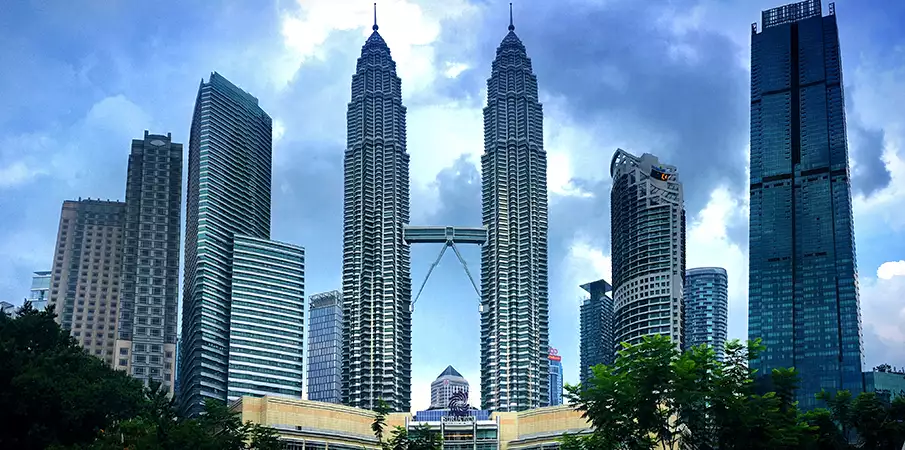
3. Batu Caves in Kuala Lumpur: Spiritual Marvel
Nestled on the outskirts of Kuala Lumpur, the Batu Caves stand as an awe-inspiring testament to Malaysia’s religious diversity and natural grandeur. A sacred pilgrimage site and a marvel of limestone formations, the Batu Caves are a captivating blend of spirituality and natural beauty.
Ascending Devotion: Steps to the Divine
-
- The focal point of the Batu Caves is the colossal golden statue of Lord Murugan, which guards the entrance and beckons pilgrims and visitors alike. Ascending the steep flight of 272 steps is not merely a physical climb but a symbolic journey toward spiritual enlightenment, surrounded by the towering limestone formations that have weathered the passage of time.
Sacred Caverns: Temples in the Heart of Earth
-
- As one reaches the summit, a network of caverns unfolds, housing intricate Hindu temples that have been carved into the natural rock formations. The echoing chants, the flickering of oil lamps, and the vividly painted sculptures create an otherworldly atmosphere, inviting contemplation and devotion.
Thaipusam Festival: A Spectacle of Devotion
-
- The Batu Caves come alive during the Thaipusam festival, a Hindu celebration that draws devotees from around the world. The piercing beats of drums, the vibrant processions, and the acts of devotion, including body piercings and elaborate kavadis (ceremonial structures), turn the Batu Caves into a kaleidoscope of spiritual fervor.
Limestone Marvel: Nature’s Hand in Devotion
-
- Beyond its religious significance, the Batu Caves are a geological marvel. The limestone formations, estimated to be around 400 million years old, create a stunning backdrop for the spiritual enclave. The natural caverns, adorned with stalactites and stalagmites, add an ethereal dimension to the spiritual journey.
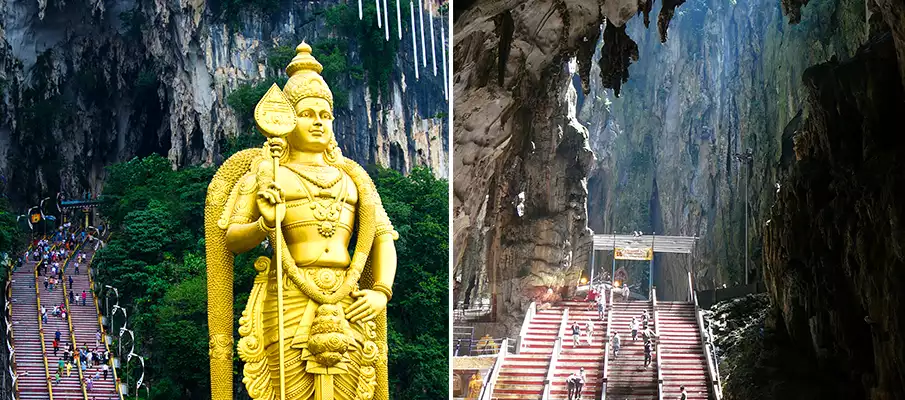
4. Penang: The Culinary Capital
Tucked away in the northwest corner of Malaysia, Penang emerges as a culinary haven, inviting travelers and food enthusiasts on a gastronomic journey through its vibrant streets, bustling markets, and rich cultural heritage. Renowned as the food capital of Malaysia, Penang’s culinary landscape is a delectable fusion of flavors that captivates the senses and leaves an indelible mark on the palate.
Street Food Extravaganza: George Town’s Culinary Symphony
-
- At the heart of Penang’s culinary prowess lies George Town, a UNESCO World Heritage Site and a melting pot of culinary treasures. The UNESCO recognition not only celebrates the city’s historical significance but also acknowledges its role as a culinary tapestry where diverse influences converge.
Char Kway Teow: Wok-Fried Delight
-
- Penang’s culinary repertoire boasts an array of iconic dishes, and Char Kway Teow is undoubtedly a star. This stir-fried noodle dish, with its smoky aroma and flavorful medley of prawns, Chinese sausage, and chili paste, is a quintessential Penang experience that showcases the skillful mastery of local street food vendors.
Penang Laksa: A Symphony of Spices
-
- For those seeking a culinary adventure, Penang Laksa beckons with its rich and spicy broth, rice noodles, and a medley of toppings, including prawns, fish flakes, and fresh herbs. This dish, a harmonious blend of Malay and Chinese flavors, encapsulates the essence of Penang’s multicultural culinary identity.
Hawker Centers: Where Flavor Takes Center Stage
-
- Penang’s hawker centers are vibrant hubs where culinary alchemy unfolds. From Gurney Drive to New Lane, these open-air food courts are a sensory delight, offering an array of dishes from Hokkien Mee to Nasi Kandar. The atmosphere is lively, the aromas enticing, and the flavors, a testament to Penang’s culinary excellence.
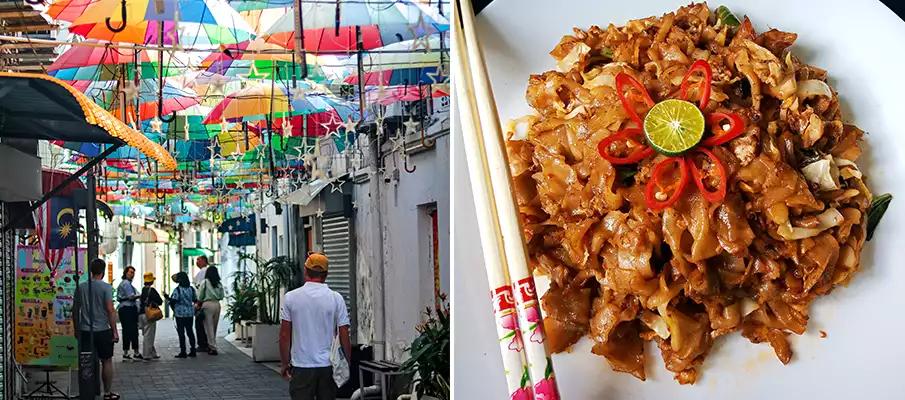
5. Malaysian Rainforests: Biodiversity Hotspot
Deep within the heart of Malaysia lies a world of unparalleled ecological richness—the Malaysian rainforests. These ancient, lush expanses, among the oldest rainforests on Earth, are not just a testament to Malaysia’s natural beauty but stand as vital repositories of biodiversity, hosting a mesmerizing array of flora and fauna.
Taman Negara: The Ancient Heartbeat of Malaysia
-
- At the forefront of Malaysia’s rainforest treasures is Taman Negara National Park. Spanning across three states, this national park is a living testament to the endurance of nature, with some parts estimated to be over 130 million years old. Towering trees, glistening rivers, and an orchestra of wildlife create an immersive experience that echoes the primordial pulse of the Earth.
Biodiversity Unveiled: A Symphony of Life
-
- Malaysia’s rainforests are teeming with life, harboring an astounding variety of plant and animal species. From the vibrant hues of rare orchids to the majestic presence of the Malayan tiger, the rainforests provide a haven for countless species, many of which are endemic and found nowhere else on the planet.
Rivers and Canopies: Nature’s Masterpieces
-
- The rainforests are crisscrossed by a network of rivers, the lifeblood of this ecosystem. Exploring these waterways offers a glimpse into the intricate web of life, from playful otters to ancient fish species. Meanwhile, the towering canopy above shelters a diverse avian population, with the resonating calls of hornbills and the vibrant plumage of sunbirds adding to the symphony of the rainforest.
Conservation Imperative: Preserving a Natural Heritage
-
- Recognizing the ecological importance of these rainforests, Malaysia has implemented various conservation initiatives. Taman Negara and other reserves serve as living laboratories for scientists and conservationists, contributing to the global understanding of biodiversity and the urgent need for sustainable practices.
Eco-Tourism: Balancing Exploration and Preservation
-
- For those seeking to immerse themselves in the wonder of Malaysian rainforests, eco-tourism initiatives provide a responsible way to explore this delicate ecosystem. Guided treks, river cruises, and canopy walks allow visitors to marvel at the natural wonders while minimizing their impact on the environment.
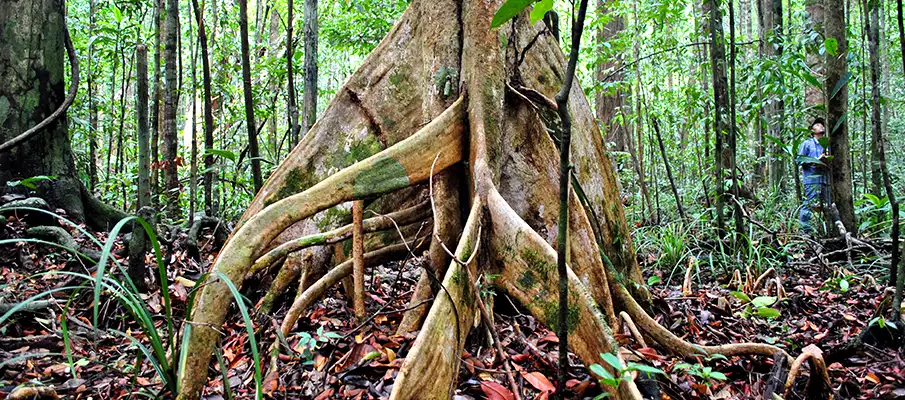
6. Cultural Festivals in Malaysia: Unity in Diversity
In the colorful tapestry of Malaysia’s cultural landscape, festivals stand out as vibrant threads that weave together a narrative of unity in diversity. From the spirited celebrations of Hari Raya Aidilfitri to the dazzling lights of Diwali, Malaysia’s cultural festivals reflect the nation’s harmonious blend of traditions, fostering a spirit of togetherness among its diverse communities.
Hari Raya Aidilfitri: The Triumph of Ramadan
-
- Hari Raya Aidilfitri, also known as Eid al-Fitr, marks the end of Ramadan, the holy month of fasting for Muslims. It is a time of joyous reunions, where families and friends come together to celebrate with feasts, traditional delicacies, and the exchange of heartfelt greetings. The streets adorned with colorful lights and the sound of takbir (prayers) echo the triumph of Ramadan and the spirit of forgiveness and gratitude.
Chinese New Year: Welcoming Prosperity and Good Fortune
-
- The arrival of the Chinese New Year, a festivity deeply rooted in Chinese culture, transforms Malaysia into a sea of red and gold. Lion and dragon dances, lantern festivals, and vibrant parades characterize the celebrations. Families gather for reunion dinners, and the air is filled with the crackle of fireworks, symbolizing the casting away of negativity and welcoming prosperity in the lunar new year.
Deepavali: Festival of Lights
-
- Deepavali, or Diwali, the Hindu Festival of Lights, illuminates Malaysia with a radiant glow. The streets come alive with colorful kolam (rangoli) designs, and homes are adorned with oil lamps, creating a mesmerizing spectacle. Deepavali is a time for family, reflection, and the triumph of light over darkness, making it a celebration that transcends religious boundaries.
Thaipusam: Devotion and Sacrifice
-
- Thaipusam is a unique Hindu festival celebrated with fervor, attracting devotees who demonstrate their devotion through acts of penance and sacrifice. Pilgrims carry kavadis, ornate structures attached to their bodies with piercing hooks and skewers, as they climb the steps to temples. Thaipusam is a testimony to spiritual dedication and the enduring strength of faith.
Wesak: Commemorating Buddha’s Birth, Enlightenment, and Death
-
- Wesak, commemorating the birth, enlightenment, and death of Buddha, brings Buddhists together for prayers, processions, and acts of compassion. Temples are adorned with colorful decorations, and devotees engage in charitable activities as a means of expressing gratitude and spreading joy to others.

7. Langkawi Island: Tropical Paradise
Nestled in the turquoise waters of the Andaman Sea, Langkawi Island emerges as a haven of natural beauty, pristine beaches, and lush landscapes. Renowned for its breathtaking scenery and duty-free status, Langkawi beckons travelers to indulge in a tropical escape that seamlessly combines relaxation and adventure.
Beaches of Serenity: White Sands and Azure Waters
-
- Langkawi boasts some of the most pristine beaches in Southeast Asia, where powdery white sands meet the gentle lapping of crystal-clear waters. Pantai Cenang and Pantai Tengah, with their palm-fringed shores, offer an idyllic setting for sunbathing, beachcombing, and water activities. The tranquil ambiance makes these beaches perfect for those seeking a serene tropical escape.
Duty-Free Delight: Shopping in Paradise
-
- Langkawi’s duty-free status transforms the island into a shopping haven. From boutique shops to bustling markets, visitors can indulge in tax-free shopping for a wide range of goods, including local handicrafts, chocolates, and electronics. Kuah, the main town, is a hub for duty-free shopping, where bargains await around every corner.
SkyBridge Adventure: A Panoramic Perspective
-
- For those seeking an adrenaline rush and breathtaking views, the Langkawi SkyBridge is a must-visit attraction. Suspended high above the rainforest, this curved bridge offers panoramic vistas of the Andaman Sea and surrounding islands. Accessible by cable car, the journey to the SkyBridge is an adventure in itself, providing a bird’s-eye view of the island’s lush landscapes.
Kilim Karst Geoforest Park: Nature’s Mystique Unveiled
-
- Nature enthusiasts find solace in the Kilim Karst Geoforest Park, a UNESCO-listed site that showcases Langkawi’s unique geological formations. Cruising through mangrove forests and limestone cliffs, visitors encounter diverse flora and fauna, including eagles, monkeys, and vibrant bird species. The Gua Kelawar (Bat Cave) and Gua Cerita (Cave of Legends) add an element of mystique to the journey. You can travel to Langkawi by boat or plane from Penang.
BOOK a TOUR / ACTIVITY in Malaysia ➜
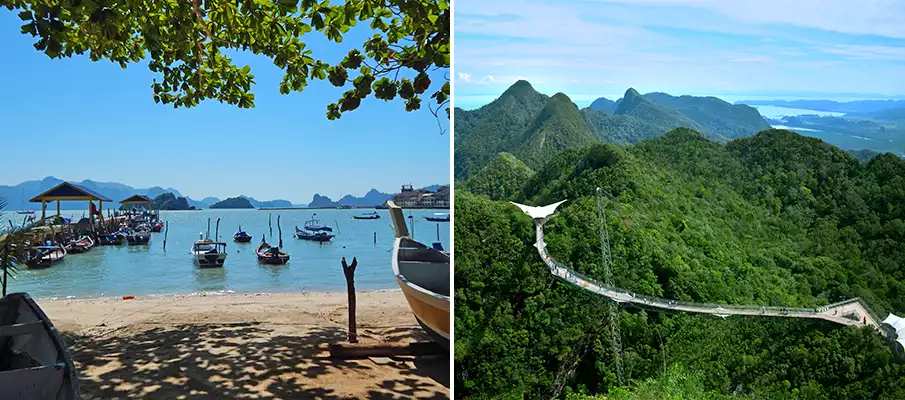
8. Traditional Games: Wau Bulan and Sepak Takraw
Wau Bulan: Soaring Traditions in the Skies
Embarking on a journey into Malaysia’s cultural heritage unveils a captivating world of traditional games, and none is more iconic than Wau Bulan. Wau Bulan, the traditional Malay kite, takes flight with a legacy that transcends generations, embodying not only the spirit of competition but also the artistry and craftsmanship that define Malaysian culture.
Craftsmanship and Culture: The Art of Wau Making
-
- Wau Bulan, with its distinctive crescent shape and intricate designs, is a masterpiece of craftsmanship. Artisans meticulously handcraft these kites, infusing each creation with cultural motifs and vibrant colors that tell stories of Malaysia’s rich heritage. The act of flying a Wau Bulan becomes not just a game but a celebration of art, skill, and cultural identity.
Wau Festival: A Kaleidoscope in the Sky
-
- The Wau Festival, held annually in Kelantan, showcases the prowess of Wau Bulan enthusiasts. Against the backdrop of the azure sky, kites of various shapes and sizes compete for attention, creating a mesmerizing kaleidoscope of colors and patterns. The festival not only fosters friendly competition but also serves as a platform to pass down the art of Wau making to younger generations.
Sepak Takraw: The Elegant Dance of Foot and Ball
In the realm of traditional games, Sepak Takraw emerges as a cultural ballet where agility, teamwork, and a rattan ball take center stage. This unique Southeast Asian sport, often referred to as kick volleyball, combines elements of martial arts, gymnastics, and soccer, offering a thrilling spectacle that showcases the grace and athleticism of its players.
Origins in the Heart of Southeast Asia: A Sporting Tradition
-
- Sepak Takraw traces its roots to the Malay Peninsula, where it has evolved into a sport that transcends borders. Played on a badminton-sized court with a net suspended high above, Sepak Takraw challenges players to score points using their feet, head, knees, and chest—excluding the use of hands. The result is a fast-paced, acrobatic display that captivates both players and spectators.
International Recognition: From Villages to the World Stage
-
- What began as a beloved pastime in Southeast Asian villages has gained global recognition. Sepak Takraw has become an international sport, with teams from Malaysia and neighboring countries participating in world championships and tournaments. Its unique blend of skill, strategy, and athleticism continues to enchant audiences worldwide.
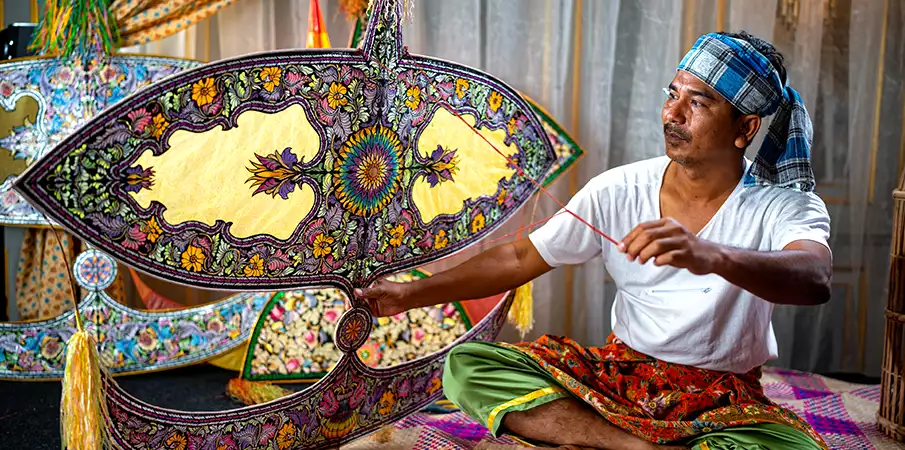
9. Sarawak Cultural Village: Living Heritage
Nestled amidst the lush landscapes of Borneo, the Sarawak Cultural Village stands as a testament to Malaysia’s commitment to preserving and showcasing its rich cultural diversity. Often referred to as the „Living Museum,“ this unique attraction offers visitors a captivating journey through time, providing a firsthand experience of the vibrant traditions and lifestyles of Sarawak’s indigenous communities.
Authenticity Unveiled: Diverse Ethnic Longhouses
-
- One of the highlights of Sarawak Cultural Village is the collection of traditional longhouses representing various ethnic communities. From the Iban and Bidayuh to the Orang Ulu and Penan, each longhouse is a faithful recreation of the architecture and cultural practices unique to its respective community. Visitors step into a realm where authenticity is not merely preserved but actively celebrated.
Cultural Performances: Rhythms and Rituals
-
- Immersing visitors in the heartbeat of Sarawak’s cultural mosaic, the village hosts captivating performances that showcase traditional dances, music, and rituals. From the hypnotic grace of the Ngajat dance to the powerful beats of the traditional drums, each performance unfolds a vibrant narrative, allowing guests to connect with the living pulse of Sarawak’s cultural heritage.
Hands-On Experiences: Crafting Traditions
-
- Sarawak Cultural Village offers more than mere observation; it invites active participation. Visitors can engage in hands-on experiences, such as trying their hand at traditional crafts like weaving, beadwork, and pottery. These interactive sessions provide insight into the intricate skills passed down through generations and foster a deeper appreciation for the craftsmanship inherent in Sarawak’s cultural tapestry.
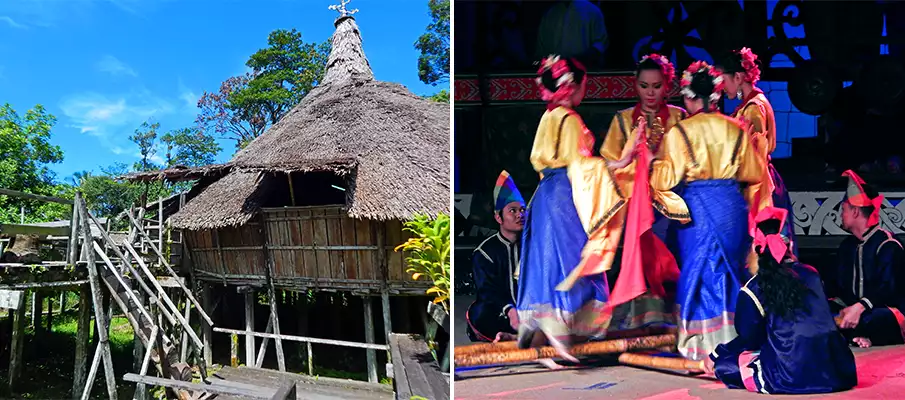
10. Malacca: Historic Melting Pot
Nestled along the Straits of Malacca, the historic city of Malacca stands as a living testament to the intertwining narratives of cultures, trade, and colonial influences. As a UNESCO World Heritage Site, this vibrant city invites visitors to stroll through its cobbled streets, where every brick, building, and artifact narrates a tale of cultural exchange and historical significance.
Colonial Chronicles: A Tapestry of Dutch and Portuguese Influences
-
- Malacca’s history is deeply rooted in its colonial past, with the Portuguese and Dutch leaving an indelible mark on its architecture and culture. Stroll through the iconic red buildings of Christ Church and the looming A Famosa fortress to witness the enduring legacy of European influence. These structures stand as silent witnesses to the city’s strategic importance in the maritime trade routes of the past.
Jonker Street: A Cultural Marketplace Through Time
-
- Jonker Street, with its bustling markets and eclectic shops, is the heartbeat of Malacca’s cultural vibrancy. Once the center of the city’s Peranakan community, this street is a treasure trove of antiques, traditional crafts, and delectable Nyonya cuisine. The air is thick with the aroma of street food, and the vibrant colors of shops beckon visitors to explore the rich cultural heritage embedded in every nook and cranny.
Stadthuys: The Dutch Administrative Hub
-
- The Stadthuys, a Dutch colonial-era building painted in a distinctive shade of red, serves as a visual anchor in Malacca’s historical landscape. Built in the 17th century, it was the official residence of the Dutch governor and now houses the Malacca Museum Complex. Visitors stepping into the Stadthuys find themselves transported to an era where administrative decisions shaped the destiny of this historic city.
Baba Nyonya Heritage Museum: Peranakan Elegance Preserved
-
- Malacca proudly showcases its Peranakan heritage through the Baba Nyonya Heritage Museum. This impeccably preserved mansion offers a glimpse into the opulent lifestyle of the Peranakan community, with its intricate furnishings, ornate tiles, and captivating stories of a bygone era. The museum stands as a tribute to the fusion of Chinese and Malay cultures that defines the Peranakan identity.
Malacca River: A Liquid Tapestry of Reflections
-
- As the Malacca River winds its way through the heart of the city, it reflects the diverse cultural influences that have shaped Malacca over centuries. A river cruise unveils the city’s landmarks illuminated against the night sky, creating a magical ambiance that encapsulates the spirit of this historic melting pot.
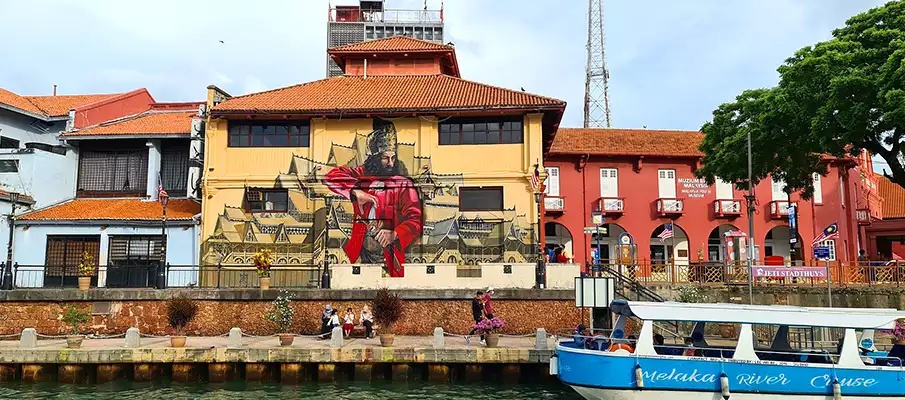
11. Orangutans of Borneo: Conservation Efforts
Borneo’s lush rainforests are not just a haven for biodiversity; they are also home to the iconic orangutans, often regarded as the „people of the forest.“ As guardians of these critically endangered primates, conservation efforts in Borneo are instrumental in ensuring the survival of these intelligent and gentle creatures.
Borneo’s Primate Royalty: The Orangutans
-
- Orangutans, with their auburn fur and soulful eyes, are the only great apes found in Asia. Borneo, one of their last remaining habitats, provides a crucial sanctuary for both the Bornean and Sumatran orangutan species. These primates play a vital role in maintaining the ecological balance of the rainforest, contributing to seed dispersal and forest regeneration.
Habitat Loss and Deforestation: A Threat to Survival
-
- The primary threat to orangutans is the rapid loss of their natural habitat due to deforestation and illegal logging. As palm oil plantations expand, the once-vast rainforests are fragmented, leaving orangutans isolated and vulnerable. The destruction of their habitats not only endangers the orangutans but also contributes to the loss of biodiversity in Borneo.
Conservation Sanctuaries: Rehabilitation and Protection
-
- To address the challenges faced by orangutans, conservation sanctuaries have emerged as beacons of hope. Centers like the Sepilok Orangutan Rehabilitation Centre in Sabah and the Borneo Orangutan Survival Foundation in Kalimantan provide a safe haven for orphaned and injured orangutans. Through rehabilitation programs, these centers aim to equip orangutans with the skills necessary for their eventual return to the wild.

12. Islamic Arts Museum Malaysia: A Cultural Gem
In the heart of Kuala Lumpur, the Islamic Arts Museum Malaysia stands as a cultural gem, offering a captivating journey through the rich tapestry of Islamic art and heritage. With its resplendent displays and meticulous curation, the museum serves as a beacon, inviting visitors to explore the beauty, diversity, and historical significance of Islamic art.
Architectural Splendor: A Cultural Oasis
-
- The museum itself is a masterpiece, with its architectural design mirroring the grandeur of Islamic civilizations. Intricate geometric patterns, archways, and domes welcome visitors into a world where the aesthetics of the building harmonize with the treasures it houses. Each gallery unfolds like a chapter, showcasing the evolution and breadth of Islamic artistic expression.
Collections Beyond Borders: A Global Perspective
-
- The museum’s extensive collections transcend geographic boundaries, featuring artifacts from the Islamic world spanning centuries. From illuminated manuscripts and intricately designed ceramics to awe-inspiring textiles and architectural marvels, each exhibit narrates a unique story of cultural exchange, innovation, and the enduring legacy of Islamic civilizations.
Spiritual Artistry: Calligraphy and Beyond
-
- At the heart of Islamic art lies the eloquence of calligraphy. The museum pays homage to the beauty and diversity of Islamic calligraphy, showcasing masterpieces that reflect the sacredness of the written word. Beyond calligraphy, exhibits highlight the artistry in Quranic manuscripts, miniature paintings, and religious artifacts that capture the spiritual essence of Islamic culture.
Cultural Diversity on Display: Regional and Historical Perspectives
-
- Islamic Arts Museum Malaysia is a celebration of diversity within the Islamic world. Galleries dedicated to different regions, periods, and themes offer a comprehensive view of the artistic evolution across time and space. Visitors can explore the art of the Ottoman Empire, the intricate designs of Andalusia, and the cultural richness of Southeast Asia—all under one roof.
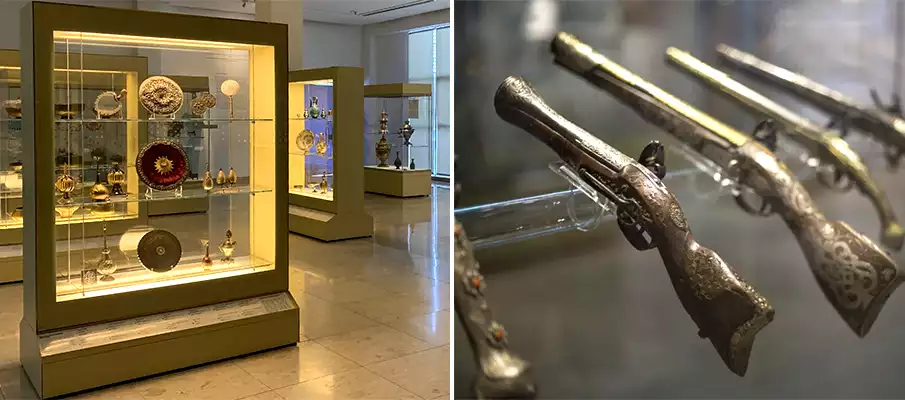
13. Malaysian Palm Oil: Economic Backbone
Malaysian palm oil stands as a vital pillar in the nation’s economic landscape, contributing significantly to its growth and development. Renowned for its versatility and widespread applications, palm oil has become an economic backbone, shaping industries, creating jobs, and playing a crucial role in Malaysia’s global trade.
Versatility in Applications: Beyond Culinary Use
-
- Palm oil’s versatility extends far beyond its role in the culinary world. A key ingredient in various food products, it also serves as a fundamental component in the production of cosmetics, soaps, and detergents. Furthermore, palm oil’s unique properties make it a preferred choice for biofuels and as an essential raw material in industries ranging from pharmaceuticals to textiles.
Economic Impact: Job Creation and Revenue Generation
-
- The palm oil industry is a significant source of employment, particularly in rural areas where plantations are prevalent. From cultivation to processing, the industry provides jobs for millions of Malaysians, contributing to poverty alleviation and socioeconomic development. Additionally, palm oil exports contribute substantially to Malaysia’s revenue, bolstering the nation’s economic stability.
Global Trade Dominance: Malaysia as a Leading Exporter
-
- Malaysia has emerged as one of the world’s largest exporters of palm oil. With a substantial share in the global market, the country plays a pivotal role in meeting the international demand for this versatile commodity. The palm oil industry’s global significance positions Malaysia as a key player in the agribusiness sector, fostering economic resilience and sustainability.
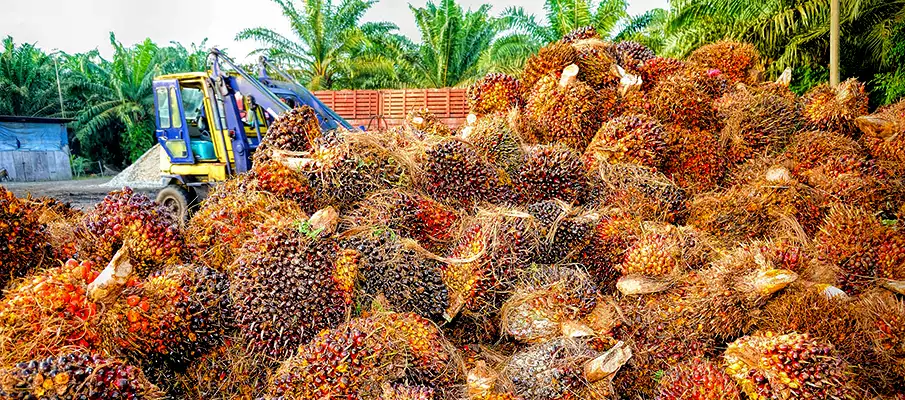
14. Perhentian Islands: Underwater Paradise
Tucked away in the South China Sea, the Perhentian Islands stand as a testament to Malaysia’s unrivaled beauty, particularly beneath the crystal-clear waters that surround these idyllic isles. Renowned for their vibrant coral reefs and diverse marine life, the Perhentian Islands are a beacon for snorkelers and divers seeking an underwater paradise.
Coral Gardens and Marine Wonders: Submerged Spectacles
-
- The Perhentian Islands boast some of the most spectacular coral gardens in Southeast Asia. Beneath the surface, a kaleidoscope of colors unfolds as vibrant corals provide a canvas for a myriad of marine life. Snorkelers are treated to encounters with tropical fish, rays, and even reef sharks, creating a mesmerizing tableau of underwater wonders.
Crystal-Clear Waters: Visibility Beyond Imagination
-
- One of the defining features of the Perhentian Islands is the exceptional clarity of their waters. With visibility that often exceeds 20 meters, divers and snorkelers are treated to an immersive experience where the underwater world comes to life in high definition. The crystal-clear waters enhance the allure of the islands, making every dive an exploration of marine enchantment.
Diverse Dive Sites: From Novice to Expert
-
- The Perhentian Islands cater to divers of all levels, offering a range of dive sites suitable for novices and seasoned enthusiasts alike. Whether exploring underwater caves, navigating through coral-laden passages, or encountering larger marine species in the open sea, the islands provide an array of dive experiences that showcase the richness of Malaysia’s marine biodiversity.
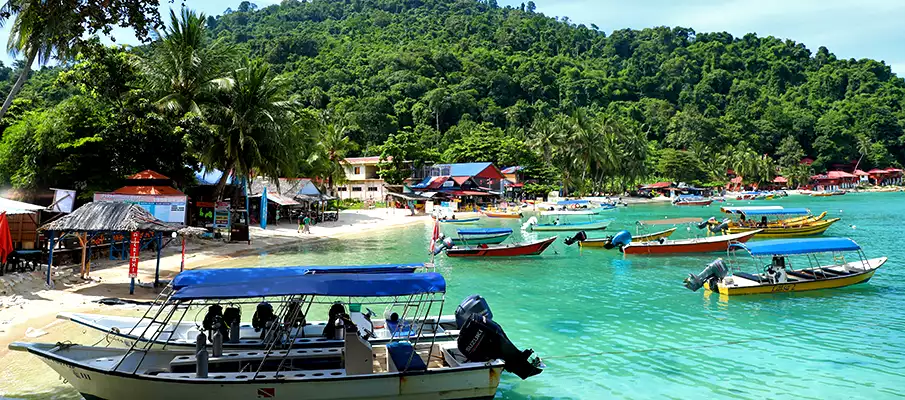
15. Melting Pot of Languages: Bahasa Malaysia and Beyond
Malaysia, a vibrant tapestry of cultures, is equally diverse in its linguistic landscape. At the heart of this linguistic mosaic lies Bahasa Malaysia, the national language, but the nation’s linguistic diversity goes far beyond, reflecting its multicultural identity.
Bahasa Malaysia: The Unifying Thread
-
- Bahasa Malaysia, also known as Malay, serves as the lingua franca that unites Malaysia’s diverse population. Its status as the national language promotes unity, fostering communication and understanding among people of various ethnicities and backgrounds. Bahasa Malaysia is not just a means of communication; it embodies the spirit of Malaysia’s national identity.
Cultural Diversity in Speech: A Multilingual Symphony
-
- Beyond Bahasa Malaysia, Malaysia resonates with a symphony of languages. The country is home to various ethnic communities, each preserving and celebrating its own linguistic heritage. Mandarin, Tamil, and English are among the languages spoken in everyday life, reflecting the rich cultural tapestry woven by the Chinese, Indian, and colonial influences.
Multilingual Education: Nurturing Linguistic Diversity
-
- Malaysia’s education system recognizes and embraces its multilingual reality. Students have the opportunity to learn in Bahasa Malaysia while also being exposed to their respective mother tongues and English. This multilingual approach not only facilitates communication but also preserves the linguistic heritage of each community.
Street Conversations and Market Banter: Daily Multilingualism
-
- Wandering through the vibrant streets and markets of Malaysia is a linguistic adventure. Conversations ebb and flow seamlessly between languages, reflecting the daily multilingualism woven into the fabric of Malaysian society. From haggling at markets to engaging in friendly banter, the linguistic diversity of Malaysia is palpable and ever-present.
Cultural Fusion in Expressions: Manglish and More
-
- In the informal realm, Malaysians have given rise to creative linguistic expressions. „Manglish,“ a colloquial blend of English with elements of Malay and other languages, exemplifies the cultural fusion that defines Malaysia’s linguistic landscape. This unique form of communication reflects the adaptability and intercultural exchange inherent in Malaysian society.
❓ Questions + Tips – Interesting Facts about Malaysia:
1. What are the must-visit historical sites in Malaysia?
-
- Malaysia boasts rich historical sites, and Malacca, a UNESCO World Heritage site, is a treasure trove. The Malacca Sultanate Palace and A Famosa fortress reflect the city’s diverse history, influenced by Portuguese, Dutch, and British colonial periods.
2. What is the cultural significance of the Petronas Towers in KL?
-
- The Petronas Towers, Kuala Lumpur’s iconic landmarks, symbolize Malaysia’s rapid modernization. Beyond their architectural marvel, the towers house the Malaysian Philharmonic Orchestra and showcase Islamic-inspired design, blending modernity with cultural elements.
3. Are there any hidden gems in terms of temples or historical sites?
-
- Kek Lok Si Temple in Penang is a hidden gem. It’s the largest Buddhist temple in Malaysia, featuring a stunning seven-tiered pagoda, intricately adorned halls, and a giant statue of the Goddess of Mercy, Kuan Yin.
4. What natural wonders does Malaysia offer?
-
- Malaysia’s natural beauty is evident in places like Taman Negara, one of the world’s oldest rainforests. The Cameron Highlands, known for tea plantations and cool climates, provide a scenic retreat, while Langkawi’s Geopark showcases ancient geological formations.
5. Tell me about the significance of the Batu Caves near Kuala Lumpur.
-
- The Batu Caves, just outside Kuala Lumpur, are a significant Hindu pilgrimage site. The towering golden statue of Lord Murugan and the limestone caves adorned with Hindu shrines attract both devotees and tourists.
6. What traditional Malaysian festivals should travelers experience?
-
- Hari Raya Aidilfitri, celebrating the end of Ramadan, is marked by vibrant cultural displays, delicious feasts, and open houses. Thaipusam, celebrated at Batu Caves, involves elaborate processions and acts of devotion.
7. Tell me about the markets and street food scene in Malaysia.
-
- Malaysia’s markets, like Petaling Street in Kuala Lumpur, offer a bustling atmosphere and diverse goods. The street food scene is a culinary adventure with dishes like Nasi Lemak, Satay, and Char Kway Teow, reflecting Malaysia’s multicultural influences.
8. What role does Islam play in Malaysian culture?
-
- Islam is the official religion of Malaysia, influencing cultural practices, architecture, and daily life. Mosques, like the National Mosque in Kuala Lumpur, showcase Islamic design, and the call to prayer resonates throughout the country.
9. How has Malaysia preserved its cultural diversity amid modernization?
-
- Malaysia celebrates its cultural diversity through programs like the Cultural Heritage Act, preserving traditional arts, crafts, and rituals. The UNESCO-listed George Town in Penang showcases a harmonious blend of cultures and traditions.
10. Tell me about the diverse cuisine in Malaysia.
-
- Malaysian cuisine is a delectable fusion of Malay, Chinese, Indian, and indigenous flavors. Nasi Goreng, Roti Canai, and Laksa are staples. The night markets, or „pasar malam,“ offer a culinary journey with an array of flavors and aromas.
11. Can you recommend any off-the-beaten-path destinations in Malaysia?
-
- The Perhentian Islands, off the northeast coast, offer pristine beaches and excellent snorkeling. Belum Rainforest in northern Malaysia is a secluded haven for nature lovers, housing diverse flora and fauna.
12. What are some unique Malaysian cultural practices or customs?
-
- The traditional dance of Joget reflects Malaysia’s cultural vibrancy, often performed during celebrations. Malay weddings feature intricate customs, including the „bersanding“ ceremony where the couple is seated on a decorated bridal throne.
13. Are there any wildlife sanctuaries or conservation efforts in Malaysia?
-
- Malaysia is committed to wildlife conservation. Sepilok Orangutan Rehabilitation Centre in Borneo rehabilitates orangutans, and the Bornean Sun Bear Conservation Centre focuses on the conservation of sun bears, contributing to Malaysia’s biodiversity.
14. How does Malaysian architecture showcase its diverse heritage?
-
- Malaysian architecture reflects its multicultural heritage. The Sultan Abdul Samad Building in Kuala Lumpur, with its Moorish, Islamic design, and the Cheong Fatt Tze Mansion in Penang, showcasing Chinese and European influences, exemplify Malaysia’s architectural diversity.
15. How to explore Malaysia – What are the transport options?
-
- In Malaysia you can use various ways of transport. There are modern KTM trains, tourist or public buses, domestic flights, private taxi, Grab or other hailing taxi services and islands are accessible by speedboats or ferries. The most popoular and cheap option are various modern buses.
16. What is the weather in Malaysia and what to expect?
-
- The weather in Malaysia varies throughout the year. Generally, Malaysia experiences a tropical climate characterized by high temperatures and humidity. The country has two monsoon seasons—the Southwest Monsoon (May to September) and the Northeast Monsoon (November to March). During the Southwest Monsoon, the western coastal areas, including Kuala Lumpur, may experience heavy rainfall. The Northeast Monsoon brings rain to the eastern coastal areas. However, the interior regions and certain islands can be visited year-round.
17. What is the currency of Malaysia?
-
- The Malaysian Ringgit (MYR) is the official currency of Malaysia, symbolized by RM. It is issued and regulated by the central bank, Bank Negara Malaysia. The ringgit is commonly abbreviated as MYR and is used for everyday transactions across the country. Banknotes and coins in various denominations make up the currency, facilitating both cash and electronic transactions. The exchange rate of the Malaysian Ringgit can be influenced by economic factors, global market conditions, and monetary policies set by the central bank.
BOOK a TOUR / ACTIVITY in Malaysia ➜
| Interesting Things and Facts of Malaysia: | Detailed Descriptions |
|---|---|
| 1. Cultural Diversity: |
Malaysia, often hailed as a „Truly Asia“ destination, is a captivating tapestry of cultural diversity. The country’s population is a harmonious blend of Malay, Chinese, Indian, and indigenous communities, each contributing to the nation’s unique identity. This multicultural coexistence is evident in the customs, traditions, and celebrations, making Malaysia a rich and vibrant cultural mosaic that welcomes visitors with open arms. |
| 2. UNESCO-listed George Town: |
George Town, the capital of Penang, is a living testament to Malaysia’s historical and architectural heritage. Designated as a UNESCO World Heritage Site, the city boasts a well-preserved collection of colonial buildings, traditional shophouses, and religious structures. The streets of George Town narrate the tale of Malaysia’s colonial past, offering visitors a captivating journey through time and a glimpse into the influences of British, Chinese, and Indian communities. |
| 3. Petronas Towers‘ Architectural Marvel: |
The iconic Petronas Towers in Kuala Lumpur stand tall as a symbol of Malaysia’s modernity and architectural brilliance. Formerly holding the title of the world’s tallest twin towers, these skyscrapers showcase a unique blend of Islamic-inspired design and contemporary aesthetics. Beyond their impressive height, the Petronas Towers represent Malaysia’s commitment to innovation and cultural integration, providing a striking skyline that reflects the nation’s progress. |
| 4. Malacca’s Historic Heritage: |
Malacca, a UNESCO World Heritage Site, is a treasure trove of historical landmarks that shed light on Malaysia’s role as a maritime powerhouse. The city’s well-preserved colonial architecture, ancient forts, and museums tell the story of Malacca’s strategic significance in global trade routes. Exploring Malacca offers a fascinating journey through Malaysia’s maritime history, from the Portuguese and Dutch eras to British colonial rule. |
| 5. Peninsular Malaysia’s Rainforests: |
Peninsular Malaysia is blessed with ancient rainforests that form a critical part of the country’s natural heritage. The lush ecosystems, exemplified by Taman Negara National Park, are not only a haven for diverse flora and fauna but also play a vital role in maintaining Malaysia’s ecological balance. These rainforests serve as living testaments to Malaysia’s commitment to environmental conservation and sustainable practices. |
| 6. Colonial Influence in Cameron Highlands: |
Cameron Highlands, situated amidst rolling hills, offers a retreat into Malaysia’s colonial past. Established during the British colonial era, this cool-climate region became a favored escape from the lowland heat. The landscape is adorned with picturesque tea plantations, Tudor-style homes, and vibrant flower gardens, reflecting the influence of British settlers in Malaysia’s hill stations and creating a serene ambiance that captivates visitors. |
| 7. Batu Caves‘ Hindu Heritage: |
Batu Caves, just outside Kuala Lumpur, is a significant cultural and religious site that reflects Malaysia’s commitment to religious diversity. The site comprises a series of caves and cave temples, with a monumental golden statue of Lord Murugan guarding the entrance. Batu Caves stands as a testament to the harmonious coexistence of various religious practices within Malaysia, showcasing the nation’s inclusive spirit and respect for cultural pluralism. |
| 8. Historic Melaka Straits Mosque: |
The Melaka Straits Mosque is a modern architectural marvel that pays tribute to Malaysia’s maritime history. Positioned on the shores of the Strait of Malacca, the mosque’s unique design, resembling a floating structure, symbolizes the historical importance of the strait in trade and cultural exchange. Beyond its aesthetic appeal, the mosque stands as a beacon of Malaysia’s cultural and religious diversity, inviting visitors to appreciate the nation’s maritime legacy from a contemporary perspective. |
| 9. Langkawi’s Geopark Wonders: |
Langkawi, an archipelago in the Andaman Sea, is home to a UNESCO-listed geopark that unravels the geological story of Malaysia. The ancient rock formations, caves, and diverse ecosystems showcase the nation’s commitment to preserving its natural heritage. Langkawi’s Geopark is not only a testament to Malaysia’s geological history but also a sustainable tourism initiative, emphasizing the importance of protecting ecologically sensitive areas while promoting responsible exploration. |
| 10. Independence and Merdeka Square: |
Merdeka Square in Kuala Lumpur holds profound historical significance as the site where Malaysia declared its independence from British rule on August 31, 1957. Surrounded by colonial-era buildings and landmarks, including the Sultan Abdul Samad Building, the square serves as a symbolic space representing Malaysia’s journey to independence. Merdeka Square stands as a testament to the nation’s resilience, unity, and the enduring spirit that continues to shape Malaysia’s identity. |
Interesting Facts – Cambodia|Interesting Facts – Laos|Solo Travel – Laos|Solo Travel – Cambodia|Floating Markets – Vietnam|Islands in Thailand
